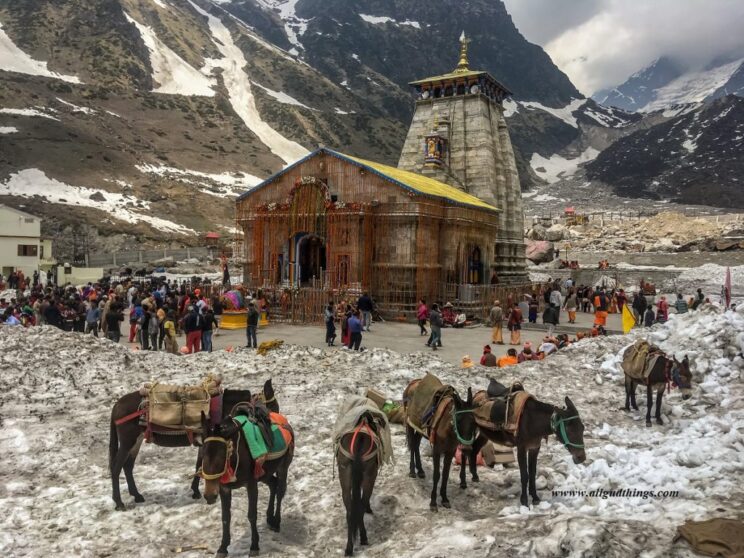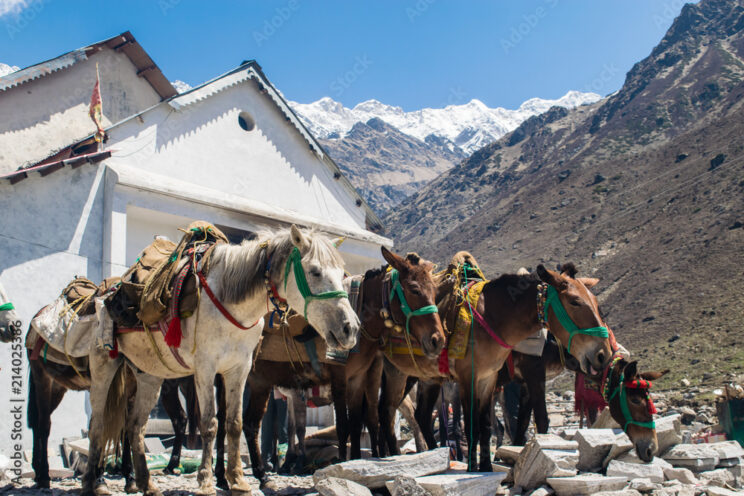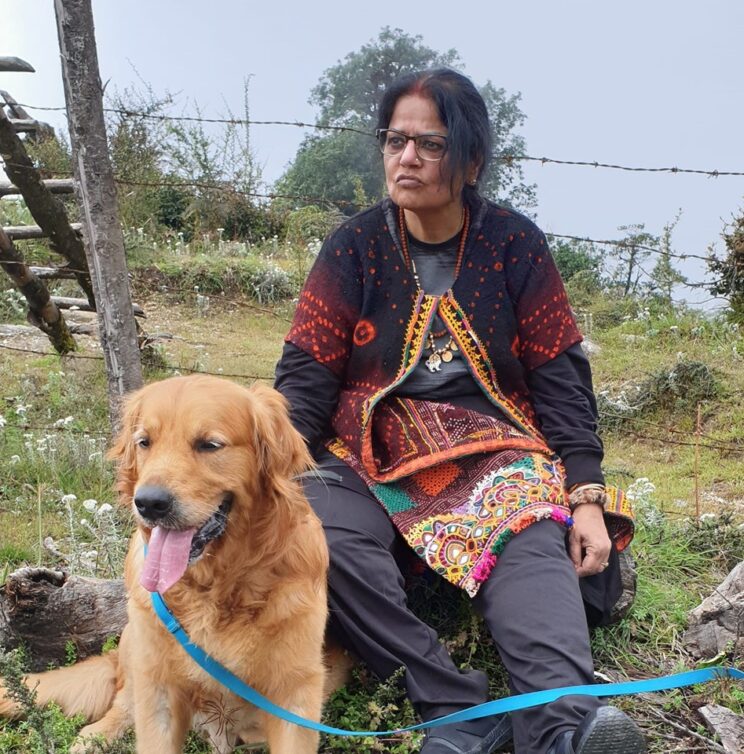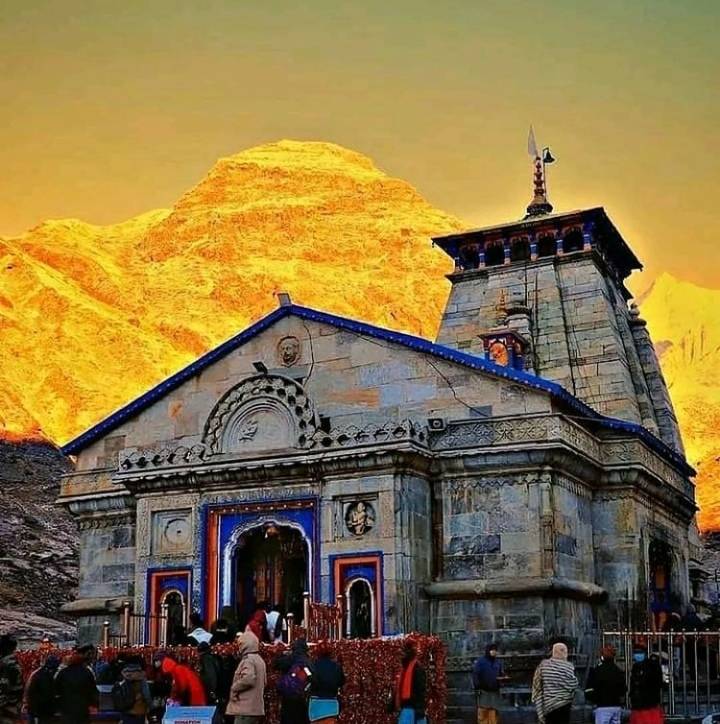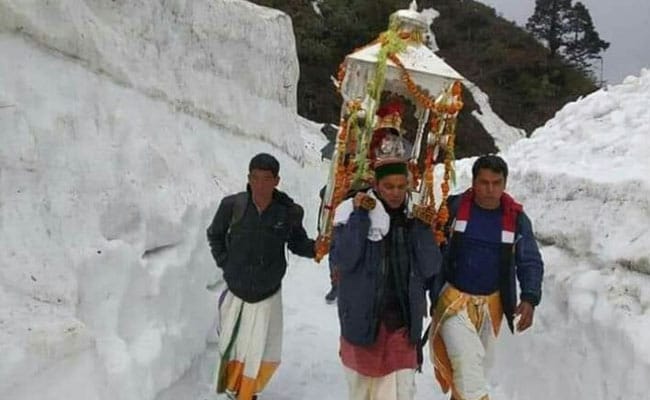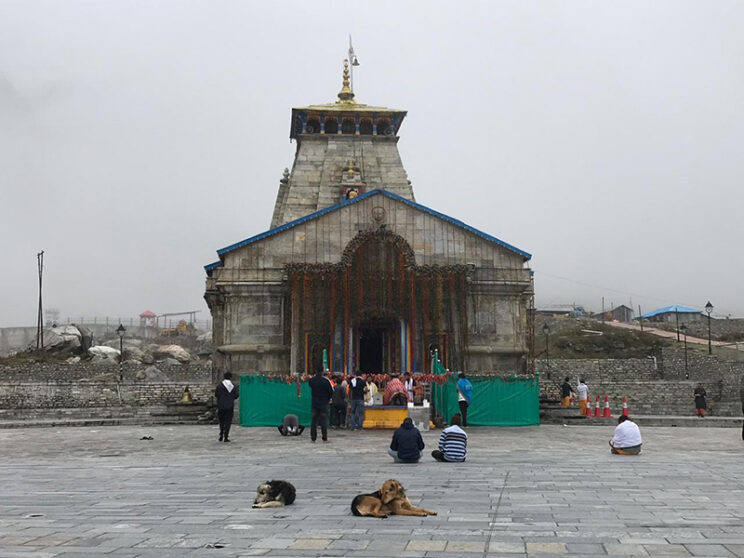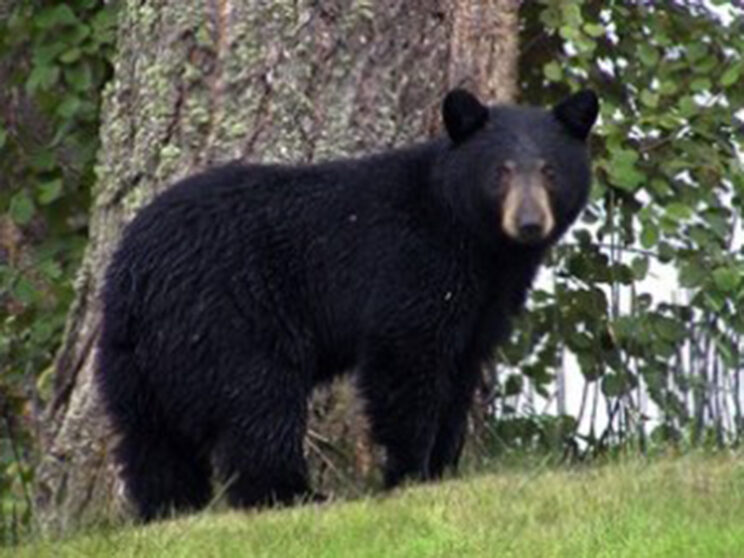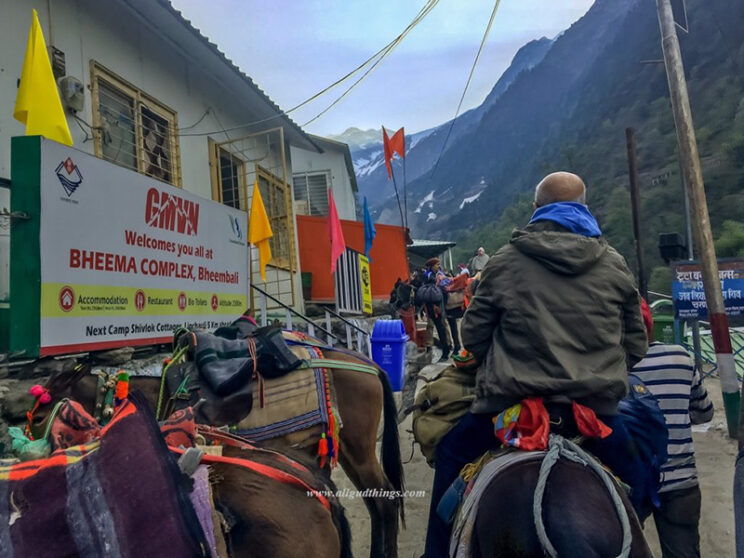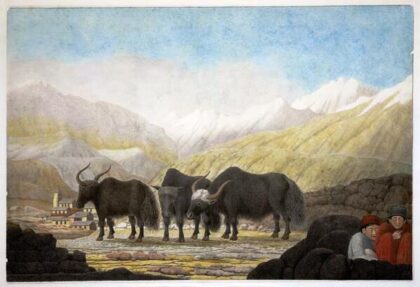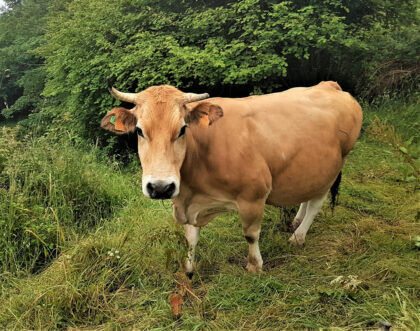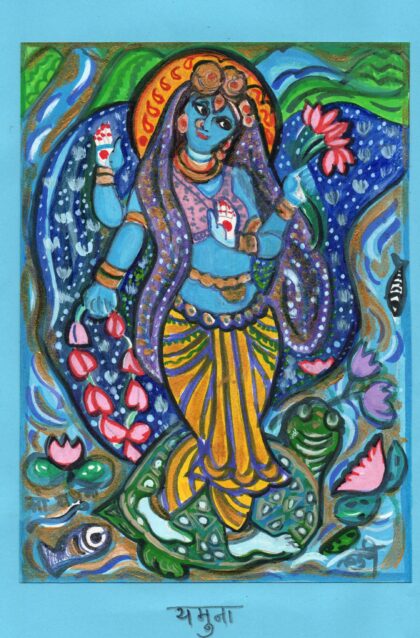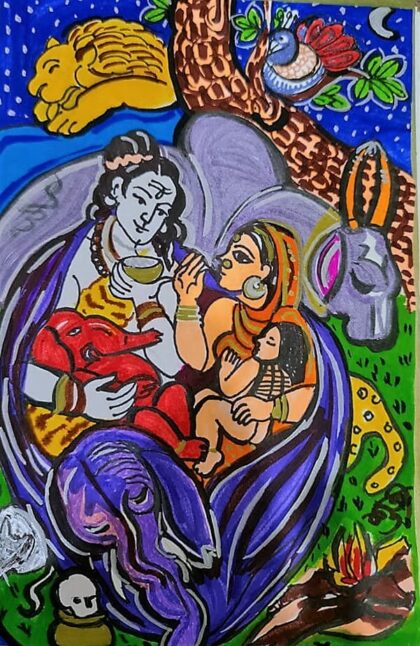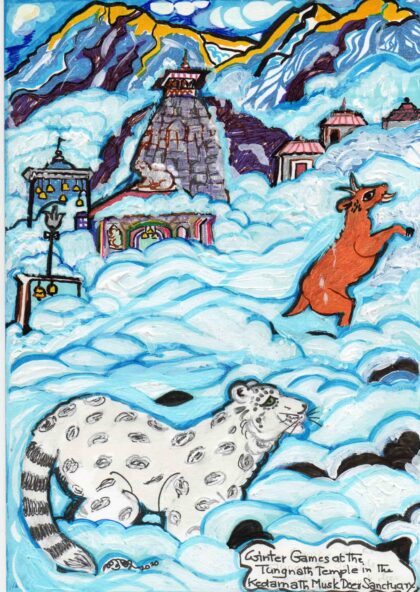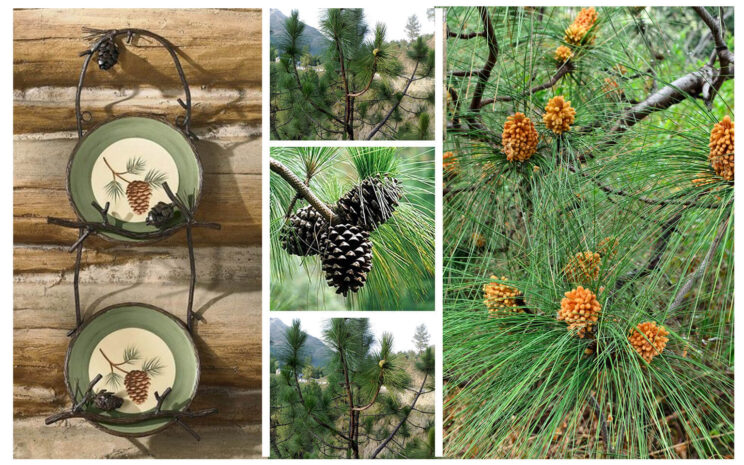Shubhi’s Pyare Pahadi: This time my dear ones are Truly Divine!
Welcome to Devbhoomi
They are coming back: the Devis and devtas are coming back to their main temples from their winter abode.
| Kedarnath | 06 May 2022 | 26 Oct 2022 |
|---|---|---|
| Badrinath | 08 May 2022 | Nov 2022 |
| Gangotri | 03 May 2022 | 25 Oct 2022 |
| Yamunotri | 03 May 2022 | 26 Oct 2022 |
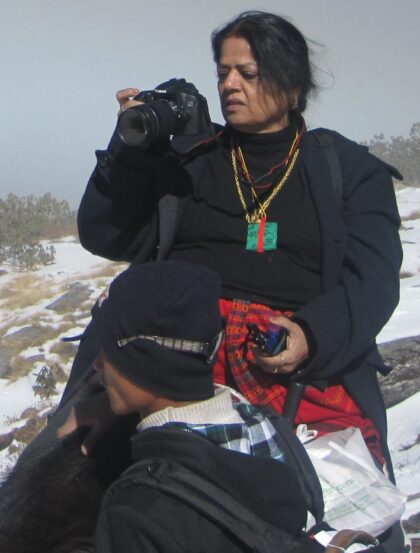 Having settled in Uttarakhand by a twist of fate since lockdown, a non believer and agnostic I never cease to wonder how almost every inch of Uttarakhand (why didn’t they officially call it simply Devbhoomi !) is steeped not only in history but religious memories, incidents and legend, or reflects the story of our greatest epics Mahabharat and Ramayan. Every river is a divine entity with such amazing, complicated stories… every cave and mountain is a holy symbol of a Devta or Devi… and all these that can fill volumes fall into place so beautifully that I am stunned… my hunger to know every story and the godly characters behind them is never satiated and I bow my godless heart in humility: how did the Writer Rishis know every mountain, every path, every river, the topography so minutely so perfectly?
Having settled in Uttarakhand by a twist of fate since lockdown, a non believer and agnostic I never cease to wonder how almost every inch of Uttarakhand (why didn’t they officially call it simply Devbhoomi !) is steeped not only in history but religious memories, incidents and legend, or reflects the story of our greatest epics Mahabharat and Ramayan. Every river is a divine entity with such amazing, complicated stories… every cave and mountain is a holy symbol of a Devta or Devi… and all these that can fill volumes fall into place so beautifully that I am stunned… my hunger to know every story and the godly characters behind them is never satiated and I bow my godless heart in humility: how did the Writer Rishis know every mountain, every path, every river, the topography so minutely so perfectly?
If you are doing all four dhams, you should start with Yamunotri Dham, then Gangotri Dham, then Kedarnath Dham and last of all, Badrinath Dham. Badrinath is done after Kedarnath as Vishnu Bhagwan, the presiding God of Badrinath Temple, would like you to tell him all about your meeting with his best friend, Shiva Bhagwan.
I would love to briefly go through these stops-and the amazing devs and devis who mean so much to us
Ma Yamuna

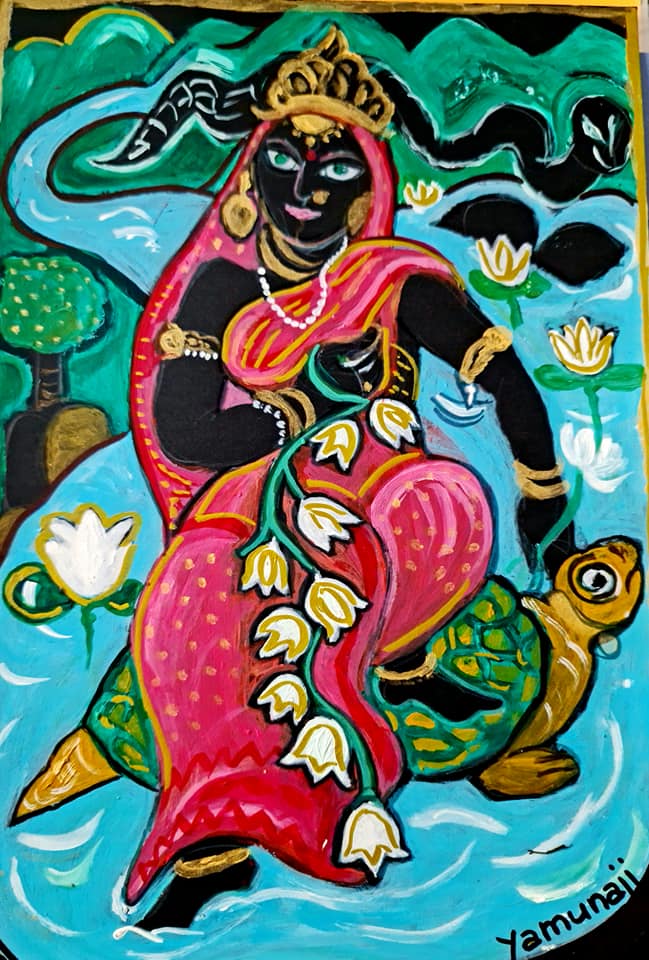
Yamuna the sacred river and the main tributary of the Goddess Ganga, is known as Yami in early texts, in later literature, Kalindi. She is the daughter of Surya, the sun god, and Sanjna, cloud goddess. Sanjna was unable to bear her husband’s heat, and it’s light and closed her eyes in his presence. Surya felt insulted and said that their son will be known as Yama (“restraint”), due to her restraint. Thereafter, Sanjna tried her best to keep her eyes open, however she flickered them, angering Surya again who proclaimed that her daughter Yama’s twin, would be Yamuna but she was blessed and would be worshipped as a goddess and remembered forever.
The twins, Yama(Yamaraj) and Yami (Yamuna) are a divine pair of creator deities: Yama is the Lord of Death, Yami is the Lady of Life. Yami addresses a hymn to Yama in the Rig Veda, describing various drinks offered to dying sacrificers in the after-life. Many communities in India celebrate Bhaiyya Dooj with the sister offering a prayer to Yamraj.

Her other illustrious brothers: Vaivasvata Manu, the first man, the twin Ashvins, divine doctors, and Shani Devta. She is Surya’s favourite child. She was in love with Vishnu praying for him to marry her so Krishna, an avatar of Vishnu granted her wish. She is one of the Ashtabharyas (group of eight principal wives of Krishna, king of Dwarka in the Dvapara Yuga). She plays an important role in his early life as a river. Even as a new born Krishna was taken through the river Yamuna… you all know that story, and when Kaliya the poisonous snake made his home in Yamuna, making the river dark, Krishna, a little child then-defeated and banished the serpent. Yamuna is seen as black in complexion (like Krishna) and stands on her mount, the tortoise, holding a water pot in her hand: a beautiful maiden standing on the banks of the river.
Yamunotri winter abode
Kharsali (7,000 feet above sea level)
When the Kapat (main door) of the Yamunotri Temple closes in the winter for six month, Ma Yamuna stays in her MAIKA (parent’s home) in the new temple in Kharsali where her UTSAV MURTI (idol) was installed in 2018.
Devotees can offer prayers to her here. Kharsali lies amongst the grand, peaceful mountains of Garhwal Himalayas. This place is one of the most popular picnic spots, far off from the maddening city crowd. The village springs to life during the time of the pilgrimage – a stopover point for pilgrims to Yamunotri dham.
As it is home to the holy temple of Shani Dev, Kharsali is a popular pilgrimage spot as well.
On the occasion of Yamuna Jayanti the muhurt (auspicious date) for opening of the Kapat of Yamunotri Dham is decided by the Yamunotri Committee and the Purohits. On the holy day of Akshaye Tritiye at 8.30 am. Yamuna’s utsav murti doli will start from Kharsali to Yamunotri dham. Jagmohan Uniyal, the vice president of Yamunotri Temple Committee would announce the time the Doors of the Yamuniotri Temple will open for the devotees. To escort her to Ymunotri her brother, Shani Dev’s doli also will go to Yamunotri Dham. Preparatios for goddess Yamuna’s departure from her winter abode Kharsali village start. The priest community and locals of Kharsali deck up the village for the occasion, decorating the shrines of goddess Yamuna and Shani Dev.
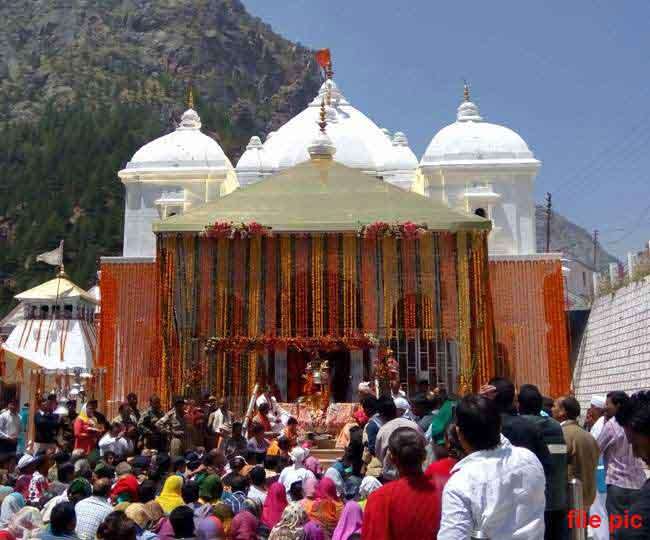
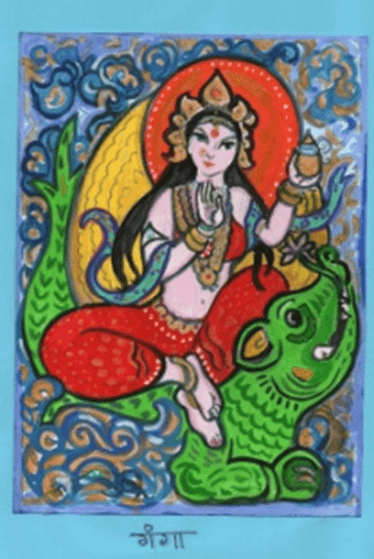
Goddess Ganga
Ganga is the most revered and sacred river in the Hindu Mythology. None of the rivers in the world has been able to win so much love and attention from people as Ganga. She is worshipped by the name Ganga Maiya (Mother Ganga) and the Gangajal (Ganga = Ganges; Jal = water) is believed to wash away all sins and grant the devotee salvation. No other river has been mentioned in the Puranas as much as the holy Ganges. Here is how Lord Vishnu has narrated the importance of river Ganges to Garuda:
“DARSHANATSPARSHANATPANATTATHA GANGETI/ KEERTANAT PUNATYAPUNYANPURUSHANA SHATASHOTHA SAHASRASHAH”
(Thousands of man’s sins are destroyed by the holy sight of the Ganges, and he becomes pure, by the touch of Gangajal, by having it, or by just pronouncing ‘Ganga-Ganga’).
Ganga is represented as a fair-complexioned woman, wearing a white crown, riding a crocodile, or makara. She holds a water lily in her right hand and a lute in her left. When shown with four hands she carries a water-pot, a lily, a rosary and has one hand in a protective mode.
As the Goddess of the river Ganga she represents purification, wellness and benevolence in the new year.Consort: Shantanu (in Mahabharata) Siblings: Parvati (younger sister)
Ganga came was convinced into coming down to Earth by Bhageerath, the grandson of King Sagar – the ruler of Ayodhya and after much penance Lord Brahma granted permission to bring Ganga to earth to save the people who were dying from drought.
Ganga felt insulted and decided to sweep away everything that came her way. Bhagiratha felt the fierce power in her current and prayed to Shiva to hold Ganga. Ganga followed Bhagiratha, with her tremendous speed. Maharishi Agastyas had emptied all the oceans on Earth by drinking all the water, so Ganga first filled the oceans and refreshed Earth. Ganga touched the ashes of the sixty thousand ancestors of Bhagiratha and blessed them to attain eternal rest in heaven.
Shiva wound her around the knot of his hair, wound her around the knot of his hair,, dividing Ganga into seven streams so she would not flood the earth upon her arrival. ( I Think Parvati resented it…. )
Mukhba Village–Winter Seat of Gangotri Temple
(Harsil, 2,620 metres above sea level) :
On the banks of the holy river Bhagirathi, with a small population surrounded by snowcapped mountain ranges, green pastures called bugyals, and hills, Mukhba holds immense relevance for Hindus as it is the exact spot where Goddess Ganga had descended from her heavenly abode to the earth.
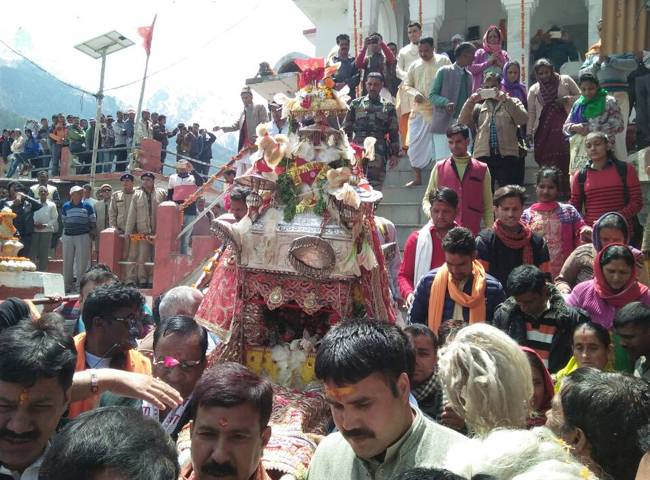
Every year the idol of Goddess Ganga is brought down to Mukhba from Gangotri Dham shrine when its gates shut down for Darshan. The village gets crowded during winter with pilgrims who offer prayers to Goddess Ganga and 2 other shrines of Goddess Ganga-one is of concrete & marbles; the other brass and deodar.
A day before the Char Dham Yatra for the year begins, a palanquin carrying the idol of goddess Ganga will leave for Gangotri shrine from Mukhba.In a grand religious ceremony held at Mukhba village, priests will carry the idol of goddess Ganga out of her temple at the “shubh muhurat” (auspicious time). Hundreds of local residents will bid an emotional farewell to the goddess “the daughter of the village.” The procession, will be led by the palanquin of local deity Someshwar Mahadev, and move towards Gangotri shrine on a traditional trek route, accompanied by an army band as well as traditional musicians. The procession is greeted at various stops by ITBP personnel, seers and local villagers. By late in the evening, the procession will reach Bhaironghati, where it will stop for the night.
“The procession of goddess Ganga will reach the Gangotri shrine in the early hours, when the portals of the shrine will be reopened after a religious ceremony at the ‘shubh muhurat’ said Suresh Semwal, president of the Gangotri Temple Committee.
The summer months at Mukhba – March and June (15 to 30 degree Celsius) Tourism booms
Nearby excursions : Tapovan and Gaumukh
A km ahead is Dharali by the banks of the holy river Ganga at an altitude of 648 metres above sea level, famous for its gleaming, fresh apple orchards and rajma cultivation, surrounded by towering pine and deodar.
The Bonus
Also nearby is the Gangotri National Park spread over an area of 2,390 sq. km., third largest national park in India. And some amazing wildlife.
The surrounding areas of the Gangotri National Park are wrapped in a fine blanket of spirituality and mythology. Being close to the holy Hindu pilgrim sites Chardham
The best time to plan a trip to the park is between April and October : coinciding with your trip to Gangotri! This time of the year, the park has long sunny days, clear skies and warm breeze, making it very pleasant for jungle safaris and trekking. (10 to 25 degrees)
Animals are the main attraction in any wildlife reserve forest and Gangotri National Park has varieties of animal species that can be spotted making the jungle safaris exciting and gratifying for tourists.
15 species of mammals and 150 species of avifauna are found here. The wild inhabitants comprise of Snow Leopard, Serows, Alpine Ibex, and many more. Endangered species such as Brown Bear, Himalayan Tahr, Musk Deer, Koklass, Blue Sheep (Bharal), rare Snow leopards, Black bears, interestingly, in recent months other endangered wildlife, including woolly flying squirrels (considered extinct 70 years ago in the IUCN Red List), wild dogs and wild cats and Manuls have also been spotted. Birds like Partridges, Pigeons, Doves, Parakeets, Bulbul, Pheasants, Himalayan Monal, Himalayan Snowcock, Himalayan Barbet. Western Himalayan Subalpine Conifer Forests and if you move higher up the valley, you will find Western Himalayan Alpine Shrubs and Grasslands in the otherwise rugged valley.
Go: on a jeep safari, bird watching, river rafting, paragliding, hang gliding, mountaineering, hiking, trekking, skiing, whatnot! The hilly terrain, glaciers, mighty rivers and lakes make it perfect for all adventure activities. Nearby: You can take a stroll in the beautiful Nelong Valley and explore the Tapovan and Gaumukh.
For nature lovers, adventure enthusiasts, as well as for the pious, this is a must-visit site to witness the splendor of nature and the Almighty.
One of the major attractions inside the park is Gaumukh glacier which is the source of the holy River Ganga and is worshipped everywhere it flows through.
Sounds exhausting? Well you came so far and saw gods. see why they love it here! Or you want to come back?
KEDARNATH TEMPLE
3,584 mts above sea level—foothills of snow bound Himalayan peaks.
The present Raval of Kedarnath and Badrinath are from South India. Shri Vageesha Lingacharya belongs to the Village Banuvalli of Taluka Harihar of Davanagere district in Karnataka.
A triangular shaped lingam is worshiped in Garbhagriha of the temple.
Mythology says that PANDAVAS wanted to wash their sins they committed during the great war of Mahabharata by killing their own brothers, so they wished to meet Lord Shiva. Shiva was angry with them and he didn’t want to bless them with his presence so he converted himself into a big bull and buried himself underground. The places where the body parts were founded were named as KEDARS. The hump of the bull was found here.
The temple was built by ADI SHANKARACHARYA in the early 8th century. One of the 12 Jyotirlingas of India & the main temple of PANCH KEDAR.
The process to open the portals to the Kedarnath shrine begins with the Utsav Doli carrying Kedar Baba leaving the Omkareshwar temple in Ukhimath in Rudraprayag district for his abode in the hills.
The Army band receives the doli (palanquin) outside the temple amid chanting of Vedic mantras and playing of traditional tunes. A crowd of devotees gather at the temple to witness the annual event. The palanquin starts its journey towards Kedarnath led by Rawal Bheemshankarling, and head priest Gangadharling, and other priests and Vedpathis. After making night halts at Fata and Gaurikund, the palanquin will reach Kedarnath shrine in the evening.
Adi Shanakaracharya Samadhi: saint and scholar who established four sacred DHAMS in India and after that he went to his Samadhi at an early age of 32. His Samadhi can be visited behind the Kedarnath Temple, freshly built after it was destroyed in the 2013 flood.
Winter abode of Kedarmath and Madhmaheshwar: Ukhimath
Kedarnath Mandir is known for being extremely sacred since it is believed that this is the exact place where Lord Vishnu meditated deeply among the ‘Kedar (a type of berry)’ fields. Some of the extremely sacred temples within the sanctuary include: Mandani, Madhyamaheshwar, Tungnath, Ansuya Devi and Rudranath
- If you are doing Kedarnath dham you are in it anyway. You can can opt for a visit to this adventurous option during your Kedarnath Yatra.
- Kedarnath wildlife sanctuary is an enigmatic part of wildlife tourism in India. The KEDARNATH Wildlife Sanctuary AKA the Kedarnath Musk Deer musk deer sanctuary or KEDARNATH VANYA JEEV PRABHA is spread over CHAMOLI and RUDRAPRAYAG districts.
- The Kedarnath temple lies outside the northern border of the sanctuary. Area-975 square km and is the largest protected area in the western Himalayas. It works for conserving the endangered Himalayan Musk Deer and was named after it.
- Other wildlife: Snow leopards, common langur, Himalayan black bear, leopard cat, yellow-throated martin, red giant flying squirrels, leopards and several exotic birds like snow partridge, grey-cheeked warbler, khalij pheasant and Himalayan Monals.
- There are housing facilities for visitors and travelers within the park premises and nearby. For staying at the forest hut in Madhyamaheshwar prior reservation is done with the help of the DFO at Kedarnath wildlife division in Gopeshwar.
- The sanctuary has within its area many temples visited by numerous pilgrims and devotees during the open seasons. For avid nature lovers, photographers, travelers, adventurers and wildlife lovers from across the country as well as the world, this wildlife sanctuary is also the largest protected area situated in the Western Himalayas with forests, alpine meadows and rocky mountains, remaining snow covered throughout the year.
- Also a bird watcher’s paradise. Kedarnath Wildlife Sanctuary officers and staff patrol on foot to Kartik Swami Temple, Rudraprayag 3050 meters above sea level with a 360 degree view of the Himalayas. This temple is dedicated to Lord Kartikeya, son of Lord Shiva, through Oak forests.
- The best time to visit Kedarnath wildlife sanctuary is between the months of May and June also the Kedarnath best time. Chopta is the entry point.
- Unfortunately there are 20-30 permanent settlements in the sanctuary, mostly in the west, and 150 in its immediate vicinity. Both residents and non-residents, depend largely on pastoralism and trade in minor forest products. Kedarnath Temple, although just outside the northern border, can be reached only by passing through the sanctuary.

Triyuginarayan Temple
The place where Lord Shiva and Goddess Parvati were married witnessed by Lord Vishnu, and Brahma.
There is a perpetual fire that is said to be burning since the time of the wedding . It organizes destination weddings: how wonderful indeed to get married here!
Badrinath Vishal


There is no authentic record about the sanctuary, yet there is a notice of the managing god Badrinath in Vedic sacred writings (c. 1750– 500 bc). As per a few records, the sanctuary was a Buddhist place of worship till the eighth century and Adi Shankara changed it over to a Hindu sanctuary. The design of the sanctuary looks like that of a Buddhist Monastery. Shankara dwelled in the place for a long time from 814 to 820 AD. He lived a half year in Badrinath and whatever remains of the year in Kedarnath.
Another story: Shankara ousted every one of the Buddhists in the area with the assistance of the Parmar ruler lord Kanak Pal. The innate successors of the lord administered the sanctuary and taxed towns to meet its costs. The Parmar rulers held the title “Bolanda Badrinath”, which means speaking Badrinath.
”Badrikashram is an eternal city and lord Narayan is its presiding deity. A mere sight of Badrikashram is enough to free a man from all the bondage of life “– Lord Siva to Kartikeya in the Skand Purana (4.2.22)
Sri Badrinath Dham is situated on a valley covering both banks of the Alaknanda river. Standing like twin sentinels over the valley are the Nar Parvat and Narain Parvat, two peaks on either side of the Alaknanda river. And far in the distance Nilkanth peak.
It always surprises me how crowded the surrounding of the temple is: there are house all around…and there are so many stories around it: even one about a tunnel that joined Kedarnath and Badrinath so the head priest could do the prayers in Kedarnatha and reach Badrinath within half an hour… The deity is seated in the Garbha Griha and Darshan can be had from the Sabha Mandapam.
The idol of Lord Badrivishal is made of black saligram, a bit weathed, lying in the Narad Kund for years. The Lord is seated in Padmasan posture, a common form of Bodhisatva sculptures. There are different views on the why the idol was in Narad Kund. One belief is that with the spread of Buddhism, the temple of Shri Badrinath was also converted into a Buddhist temple, and the idol was thrown in the Narad Kund. The Skand Purana gives an account of how Adiguru found it: When the Adiguru was climbing to a place called Ashta Khand for meditation, he heard an Akashvani: “Shankar, the thing thy wanteth to attain through meditation, can be attained by thee, by re-enshrining the idol of Lord Vishnu, which lays asleep in the Narad Kund. Avail of this opportunity and be blessed for having done so”. In pursuance of this divine order, Adiguru dived into the Narad Kund and recovered the idol of Lord Vishnu, which he duly re-enshrined, and once again Sri Badrinathji became a Hindu Temple.
The locals have a colorful story: how Badrinath chose their valley for his home.
Lord Badrinath was earlier worshipped in Tholingmath in Tibet.
Tholingmath then was a vibrant centre of vaishnava pilgrimage. Lord Vishnu is a vegetarian and he does not like animal sacrifices. The people of Tholingmath slowly started to offer animal sacrifices to Lord Vishnu. Angry with them Vishnu decided to run away. The people of Tholingmath however came to know of this plan and so they took care to lock all the temple doors and gates from the outside. Vishnu escaped by bursting open the roof of the Tholingmath temple and fled to India, through the Niti Pass. The Tibetans rode in hot pursuit and managed to catch up with him. Luckily there were some yaks grazing in the area and Lord Vishnu managed to hide under the bushy tails of the yaks who were very glad to protect Lord Vishnu. Lord Badrinath entered India and made his home in the Badrinath valley.
The local legend suggests that the present idol of Lord Badrinath was brought from Tholingmath, by a dedicated priest fed up with the ways of the local people. Although Badrinath is located in North India, the Rawal is traditionally a Nambudiri Brahmin chosen from the South Indian state of Kerala. This tradition is believed to have been initiated by Adi Shankara, who was a South Indian philosopher. The deity is seated in the Garbha Griha and Darshan can be had from the Sabha Mandapam. Nobody but the Raval can touch the idol. The royal family of Tehri sends the sesame oil for anointing the idols. The Raval is a reprentative of the king of Tehri.
Yogadhyan Badri, aka the Yoga Badri, at a distance of 13 km from Badrinath in Pandukeshwar near Govind Ghat. It is an ancient temple and is a home for Lord Vishnu.
The father of Pandavas, King Pandu meditated at this site so Lord Vishnu cleanses him for his sin of killing two mating deer. The Pandavas were born in the same place and Pandu also died at this site.
Pandu had installed an idol of Lord Vishnu in Yogadhyan Badri.
The closing ceremony is five days long
- On the second, elaborate food offerings are made at the nearby temple of Adi Kedareshwar.
- On the third, the Vedas are recited and all religious books closed.
- On the fourth, the chief priest, Ishwar Prasad Namboodri, dressed as a woman, takes the murti of Lakshmi and places it to the left of Lord Vishnu. All the embellishments and jewelry of Lord Vishnu’s murti are removed and packed, and He becomes Nirakar, the Formless God.
- On the fifth day, the pilgrims start gathering at the temple before sunrise, many using the sulfur springs for relief from the cold. Puja worship begins at 4:30am. Midway through the morning,
- Ishwar Prasad Namboodri removes all floral decorations from the murti and dresses it in the woollen coat stitched by the women of Mana. In front of the temple, some of the crowd dance in ecstasy, shouting “Jai Badri Vishal.” Music is provided by a bagpipe band of the Indian Army’s Garhwal Scouts, permanently stationed at Joshimath.
Finally, on the temple entrance: The CEO of the temple, will escort Ishwar Prasad Namboodri as he walks backward down the steps holding the statue of Uddhava on his head.
This and several other murtis will be sent down to Pandukeshwar and Joshimath for the winter. The ritual is over in just a few minutes, and the temple doors are closed. People bow their heads in gratitude to the Gods for blessing the world with everything.
Only a handful of sadhus and army people remain in Badrinath for the winter. Many pilgrims come here every year for the closing. During winters when the temple is closed for six months the idol of Lakshmi is taken inside next to her husband and the idol’s of Udhav and Kuber are moved to Yogdhyan temple in Pandukeshwar (Yog Badri one of the panch Badri temples). It is on the Joshimath—Badrinath route situated very near Govindghat the place from where treks to valley of flowers and Hemkund Sahib start Unlike the belief the main idol is not shifted to Joshimath or anywhere else.
During winters when the temple is closed for six months the idol of Lakshmi is taken inside next to her husband and the idol’s of Udhav and Kuber are moved to Yogdhyan temple in Pandukeshwar ( Yog Badri one of the panch Badri temples). It is on the Joshimath—Badrinath route situated very near govindghat the place from where treks to valley of flowers and hemkund sahib start Unlike the belief the main idol is not shifted to Joshimath or anywhere else The chief priest of the temple, Ishwar Prasad Namboodiri, will open the portals of the temple at 4.15 am chanting Vedic hymns and praying for the well-being of all. The temple is decorated with around eight quintals of marigolds on the occasion. With the opening of Badrinath, all the four Himalayan temples known as char dham are now open in Uttarakhand. After six months the oil lamp will still burning that was lit at the closing… they know how much oil to put there!
A three day trek from Badrinath takes you to Satopanth lake, this is the last journey of the Pandavas. Currently no one stays at Satopanth during winters, there are a few babas, Sadhus who stay there during summers only.
Lord Shiva is called Pashupatinath because only
By his grace can the jiva be liberated from the pasha or the bondage caused by maya. The Lord who can make the pashu (animal) free from the pasha and grant liberation.
Pashupati avatar of Shiva as “lord of the animals”. Also the national deity of Nepal. The five faces of Pashupatinath represent various incarnations of Shiva; Sadyojata (aka Barun), Vamdeva (aka Uma Maheswara), Tatpurusha, Aghor & Ishana. They face West, North, East, South and Zenith respectively, representing the five primary elements namely earth, water, air, light and ether. Lord Pashupatinath started living in Nepal in the form of a deer because he was enchanted by the beauty of Kathmandu Valley
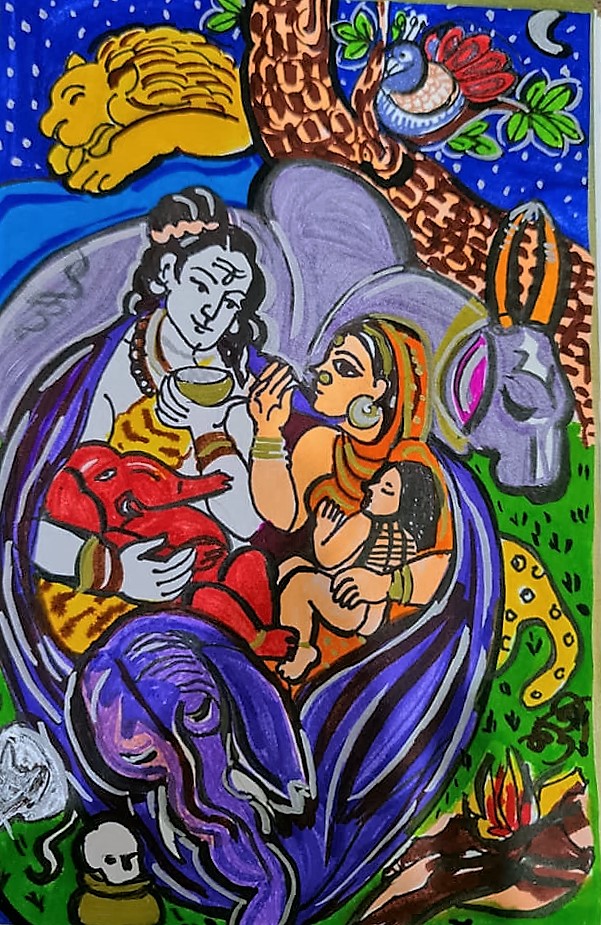
So lets count some of the animals around our Lord of all animals:
Starting with the beautiful dark stone Nandi in front of the Shiva temples seated on a pedestal and mush revered by all those who come here.
By human design or divine inspiration, the wonderful Kedarnath Wildlife sanctuary full of exotic animals and birds goes near the Kedarnath temple and several Shiva temples. Recently even the Royal Bengal tiger made its home here (see my blog no1).
I was very intrigued by a lion like statue on the Tungnath temple which the pundit told me was an animal only found in this area. Well he didn’t clarify if its still here…

There are many Bhutiya dogs in the mandir who stay there all year long, right in the front of the temple.
Nobody minds them and it keep the winter workers company. Nobody minded my golden retriever either when he went to Tungnath Temple.
Dogs are associated with one of the incarnations of Lord Shiva, God Bhairava with a black dog as it is an incarnation of Bhairava. LORD BHAIRAVA.
Rudra, Bhairava and Virabhadra are the fierce manifestations of Lord Shiva. Rudra is described as Shvapati meaning ‘master of the dog.’ The dog ‘Shvan’ is Bhairava’s divine vahana. ‘Vahana’ means vehicle or transporter.Bhairava means “Terrible” or “Frightful”. Bhairava is the fierce manifestation of Lord Shiva and His annihilation attributes.
Lord Dattatreya an incarnation of the Trimurti (Brahma, Vishnu and Mahesh was always followed by four dogs which symbolically represent the four Vedas. Lord Yama had taken the form of a Dog to accompany Yudhistira during their final journey.
He was testing the dharma of the Pandavas.
Indra has a dog named Sarama The Bhagavata Purana regards Sarama as the mother of all beasts of prey. This dog is supposed to have helped the Devas bring back their stolen cows by demons. Sarama is the daughter of Daksha (sister of Sati). Yama the Hindu God of Death has four Dogs guarding his treacherous adobe. These four dogs have four eyes and are demoniacal enough to scare away any creature
Cows and Gaushalas
No more packaged milk! BKTC transports cow to Kedarnath for milking- In Kedarnath Dham, the milk ceremony of Lord Kedarnath has started with the milk of the local cow. Although Baba’s milk has been done before, but it is done using plastic bags and cans of milk. To consecrate (make pure) a place; Gospands (beneficent cattle) like cows, goats, lambs etc are set free to graze for a minimum period of seven months! The urine and excreta (taro and gobar) of the innocent animals help destroy pockets of sprites and dark forces, if any, and make the whole area peaceful and pure (in this regard, it is very pertinent to point out that some years ago, when in Chernobyl, Russia, there was a leakage of radioactivity, scientists were pleasantly surprised to find that houses which were splattered with the urine and gobar (dung) of cattle, there was hardly any adverse radiation)
Vinod Shukla, the pilgrim priest of Kedarnath, has built a cowshed near the temple. Shivling is being bathed with this cow’s milk. Free milk is also given to pilgrims for Abhishek. It is not easy to raise a cow at an altitude of eleven and a half thousand feet. To protect the cow from the cold, mattresses are made for the cow to sleep at night, and blankets are given on top. Despite difficulties the adversity, the pilgrim priest Vinod Shukla did not lose his courage, he got engaged in the service of the cow. They bring regular fodder, hay for the cow even in the cold winter. This cowshed has been named as Ramakrishna Gaushala. The Badri-Kedar temple committee has delivered the cow to Kedarnath Dham, and every day pure milk of the cow is being taken out and offered to Baba.
Mules
Since the corona lockdown, owners had to abandon Char Dham pack animals in Uttarakhand and Animal rights activists in the state tried to raise funds to rehabilitate these animals as their owners were out of work after the Char Dham yatra was cancelled. The Uttarakhand government had earmarked ₹2.50 crore to take care of destitute bovines even as it grappled with a large number of donkeys and horses abandoned by their owners who are unable to take care of them during the lockdown due to lack of work. Gauri Maulekhi, member secretary of People for Animals Uttarakhand (PFA) said since the lockdown was imposed, there was a sudden spike in donkeys and horses found stray on roads in Dehradun, Haldwani among other places.
But the Mule or Khacchar is iconic in our mountains especially in the high temples… and here they are more for transporting people not only as pack mules…
Mules have harder hooves than horses which makes them great for rocky terrain. Mules’ hooves are less likely to split or crack and can withstand mountainous trails and rocky farm soil. For many owners around the world who may not be able to regularly replace horseshoes, this means that mules are cheaper to keep. Mules are one of the most commonly used working animals in the world, highly prized for their hardiness and docile nature.
Mules require less food and have more stamina than horses of the same weight and height, making them resilient working animals in some of the harshest environments.
Mules are less stubborn and more intelligent than donkeys
Don’t let the old saying “as stubborn as a mule” fool you: mules are thought to be more docile than their donkey fathers. But a mule’s intelligence also means that they are more cautious and aware of danger, making them safer to ride when crossing dangerous terrain.
The skin of a mule is less sensitive than that of a horses and more resistant to sun and rain
Mules can live up to 50 years if well looked after.
Mules can kick sideways . Although mules are usually docile, an angry mule can kick both backwards and to the side. Avoid a mule’s hind legs as these animals can pack quite a punch!
China breeds seven million mules each year where they are commonly used on small farms and for transport.
Near the Kedarnath temple a biogas and compost plant in Gaurikund will make electricity from the excreta of the mules. From the horse and mule poop, which lines the road to the temple will be made into fertilizer also in pits in Gaurikund. There are 120 mules which will provide enough poop to prepare the fertilizer in 30 days. This will be sold to local farmers at very reasonale rates.
But the strong impact of Prime Minister Narendra Modi’s Swacchh Bharat Abhiyan has resulted in a unique scheme: all the pack animals will wear diapers! In the Yamunotri and Kedarnath temple track diapers will be handed to the owners of the mules. There is a complicated economic arrangement between the BKTC and the mule owners for this diaper called the poof bag, but I shudder to think where the the diapers will be disposed of! And what about the bio gas plant for energy, compost and manure being built in Gaurikund using the excreta of mules? How will it be collected from the poof bags?
Yaks the Camel of the Himalayas
In 1962 during the Sino Indian war, a herd of yaks crossed the border into India from Tibet. The Indian Army handed them over to the District administration, and since then, the Animal husbandry Department of Chamoli has looked after them which have grown into a pack of 5 male and 8 female yaks. In winter they are taken to Suraithota and in summer they stay in the high altitude Dronagiri village. In Uttarakhand about 67 yaks stay in Chamoli, Pithoragarh, and Uttarkashi . They are found in areas 8000 feet above sea level. They can survive for upto 20 days, just eating snow! That is why they are also called the camel of the Himalayas.
While Char dham tourists come to Uttarakhand for a beautiful religious experience among the spiritually inspiring natural beauty of this place, but a little fun and novelty never hurts: If things go well in the times to come, they can have rides on these exotic long haired animals, known as snow camels. I was in love with the yak I rode in the Tsomgo Lake, Sikkim with an apt name: Rambo! The top of his white, hairy head was as big as a coffee table… When the Chardham Yatra will start the yaks will be kept at Badrinath, in winter they go to Auli.
It is believed that yak hair is used to make the jhubba (a hair fan) used to fan the idol of Lord Vishnu in the Badrinath temple.
The Pandavas’ last stop before entering heaven was Mana, India’s last village on the border with Tibet, three kilometers from the Badrinath temple. They reached the village riding on yaks. You could go to Mana or Niti and have “Tea in the last shop in India”
I have not included any details that we can find on the net anyway just some thoughts…
213 years old watercolour painting of Himalayan Yaks & in Badrinath temple in Uttarakhand was painted by a foreign artist in 1808.
So I leave with my paintings of these winter journeys in and around the holiest mountains of Uttarakhand
My 1st pilgrimage in Uttarakhand: Tungnath. With my driver of 30 years Kanhaiyya, nurse Pinky, my good friend, Madan Rajan and my dog Swami. And since then I have visited only one more Temple : The Nanda Devi temple in Lata. I hope to visit more. Inshallah.


